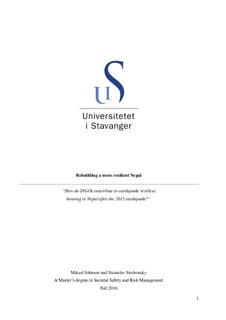| dc.description.abstract | Summary
The devastating earthquake in April 2015 showed Nepal's massive vulnerability towards earthquakes. The damages extend to approximately 712.000 houses. The lack of progress in development and risk reduction from the government before the earthquake led to the arrival of many International Non-Governmental Organizations, which realized that the government has limited capacity and prior success in the field. The purpose of this study is to investigate how resilient housing activities are driven in the context of developing country like Nepal, and how INGOs can contribute to reducing vulnerability towards future earthquakes, through cooperating with the government in the reconstruction of resilient housing. The INGOs have experience in disaster management and are bringing new knowledge, experience, and resources which they are expected to implement during the reconstruction, but they lack knowledge about the context of the country.
The research areas have been the capital, Kathmandu and Gorkha District, which was the epicenter of the 2015 earthquake. The measures of the studied INGOs were followed by the interaction with The Shelter Cluster and the Housing Reconstruction Recovery Workgroup.
As a theoretical framework, we used the PAR-model to explain how the existing vulnerabilities before the earthquake transcended into the disaster. We identified the political system, poverty and lack of local institution as the mains sources of vulnerability. The measures that INGOs are implementing are focused on the latter ones, implementing the theoretical concepts of building back safer, awareness and capacity building. INGOs are contributing to earthquake resilient housing through five key measures incorporated into the process of reconstruction: seismic resilient house design, implementation of building codes through training, increasing community awareness, social mobilization, and financial support. The successful combination of the five measures will lead to a more resilient and sustainable housing that are less vulnerable to future earthquakes. The implementation power of the INGOs depends on the relationship to the government. If the relation is close and based on a long-term relationship, the flexibility to implement the programs increases. This can result in more efficient house reconstruction. The INGOs present in Nepal dispose financial resources to cover the reconstruction of approximately 5 % of the affected houses. The INGOs role on a large scale is less significant than we expected. At the same time, the government has huge amounts of financial resources available for the reconstruction, but does not seem to be able to distribute those efficiently to the affected people. However, since the government system fails to reflect the existing vulnerabilities, in some cases by not being physically present in the villages. The most significant contribution of the INGOs to resilient housing reconstruction is by increasing the local capacity and awareness related to earthquake resilient housing in the rural areas. INGOs can also supplement the role of the local government through the access to information, that the government fails to provide to rural communities. | nb_NO |
